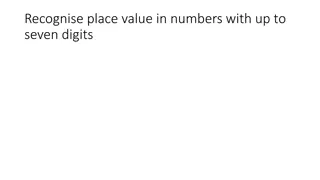Where do the magic numbers come from?
Model for estimating absolute numbers of stock abundance from catch data, considering factors like natural mortality and consistent deviations over time. The model uses relative measures to determine stock health and mortality rates, emphasizing the importance of accurate catch data for reliable estimates.
Download Presentation

Please find below an Image/Link to download the presentation.
The content on the website is provided AS IS for your information and personal use only. It may not be sold, licensed, or shared on other websites without obtaining consent from the author.If you encounter any issues during the download, it is possible that the publisher has removed the file from their server.
You are allowed to download the files provided on this website for personal or commercial use, subject to the condition that they are used lawfully. All files are the property of their respective owners.
The content on the website is provided AS IS for your information and personal use only. It may not be sold, licensed, or shared on other websites without obtaining consent from the author.
E N D
Presentation Transcript
UALG Where do the magic numbers come from? The signal in the input data
The assessment model in mathematical terms 2 ( ) 2 a a full for e a a L = full s ( ) a 2 a a full for e a a R full = F s F = ay a R y = = 1 or a = 1 a y , a y + ( ) F M 1 a N N e 1, 1 1, 1 a y a y plus = , 1, 1 a y a y 11 a a + + ( ) ( ) F M F M + N e N e 1, 1 1, 1 , 1 , 1 a y a y a y a y plus 1, 1 , 1 a y a y ( 1 ) F C + ( ) F M , a y M = e N , a y ay ay ay + F , a y ay = U q N ay a ay ( ) ( ) 2 2 = + ln ln ln ln SSE C C U U min C a ay ay U a ay ay y a y a
Another way of putting it: 3 We have: Relative measures of stock abundance (Uay) Absolute measures of removals from the stock (Cay) We want: Absolute numbers of the stock (Nay) Removals relative to stock abundance (Fay) But where does the model pick up the information on Nay and Fay from the measurements?
Signals in the catch data: The absolute value 4 The catch data are the only data that contain any absolute information (millions of fish caught) Thus the absolute numbers in the stock (Nay) must come from the catches But accuracy hinges on: That the natural mortality is reasonable close to reality That the catch data do not deviate too much from what is actually removed from the fisheries However: The advice may be fair, if the deviations are consistent in time
Signals in the catch data: The total mortality 1 5 The stock equation is: Z += N N e , a y + 1, 1 , a y a y Taking a logarithm gives ( ) ( ) = ln ln N N Z + + 1, 1 , , a y a y a y ( ) ( ) = ln ln Z N N + + , , 1, 1 a y a y a y N , = a y ln Z t N + + 1, 1 a y Thus, we do not need an absolute estimate of abundance, only the relative abundance of each from one age group to the next
Signals in the catch data: The total mortality 2 6 The math: If there has been no change in effort over time or in catchability by age/size one can use the log ratio of the number of fish caught at each stage to estimate the total mortality. C E , a y = = CPUE q N , , a y a a y , a y = = If we assume: and E E q q + + + + , 1, 1 , 1, 1 a y a y a y a y N , a y = ln Z , a y N + + 1, 1 a y This derivation show that if we have some measurement of catches by age (or length) we can estimate Z. ( ) C E q ay ay ay q = ln ( ) C E + + + + + + 1, 1 1, 1 1, 1 a y a y a y C , a y = ln E: Effort q: Catchability C + + 1, 1 a y
Another way of putting it: 7 If we assume that F=qE we can show that: C F , , a y a y + ln ln averageZ C F + + + + 1, 1 1, 1 a y a y Thus, the log catch ratio: Contains the whole mortality information and nothing else Can give us some ideas about the order of the total mortalities, but is modified by changes in fishing mortalities
The catch development of ONE cohort 9 Decline in older ages a true measure of Z if qa does not change with age and if Fa does not change with time Younger fish less available (qa changes with age) 3.0 Catch in each age (time) class 2.5 Catch (millions of fish) 2.0 1.5 1.0 0.5 0.0 3 4 5 6 7 8 9 10 11 12 13 14 Age / time
Total mortality signal of older fish: Part 1 10 iHaddock 1990 year class 3 0 Catch in numbers (Ca,y) 4 2 5 5 Fj ldi fiska afla (millj nir) 2 0 6 1 5 3 1 0 7 5 2 8 9 0 1 9 9 2 1 9 9 3 1 9 9 4 1 9 9 5 1 9 9 6 1 9 9 7 1 9 9 8 1 9 9 9 year r
Total mortality signal of older fish: Part 2 11 iHaddock Logarithmic scale 1990 year class 1 0 0 Catch in numbers (Ca,y) 4 5 6 Fj ldi fiska afla (millj nir) 3 1 0 7 2 8 1 9 0 1 9 9 2 1 9 9 3 1 9 9 4 1 9 9 5 1 9 9 6 1 9 9 7 1 9 9 8 1 9 9 9 year r
Total mortality signal of older fish: Part 3 12 iHaddock Catch curve analysis 1 0 0 Catch in numbers (Ca,y) 4 5 6 Fj ldi fiska afla (millj nir) 3 1 0 7 2 8 Z = 0.48 (38%) 1 9 0 1 9 9 2 1 9 9 3 1 9 9 4 1 9 9 5 1 9 9 6 1 9 9 7 1 9 9 8 1 9 9 9 year r
Total mortality signal of older fish: Part 4 13 iHaddock 1 0 0 Catch in numbers (Ca,y) 90 4 5 92 6 Fj ldi fiska afla (millj nir) 3 89 1 0 87 91 7 88 2 8 1 9 0 1 9 9 2 1 9 9 3 1 9 9 4 1 9 9 5 1 9 9 6 1 9 9 7 1 9 9 8 1 9 9 9 year r
iCod: Estimates of total mortality (Z) 14 Z = F + M 1 1 Year class 1989 Ln catch in numbers (ln Ca,y) 4 4 5 6 Z = 0.54 (42%) 5 1 0 6 7 3 7 3 9 8 Fj ldi afla 9 8 8 Year class 1985 Z = 1.41 (75%) 7 9 6 5 1 9 8 81 9 8 91 9 9 01 9 9 11 9 9 21 9 9 31 9 9 41 9 9 51 9 9 61 9 9 71 9 9 8 year r
Signals in the survey data 15 The survey data: Are in most cases only relative indices, i.e. U = q N , , a y a a y Since q is in those cases unknown and is a parameter normally estimated in the model, the absolute numbers in the stock (Nay) must come from the catches But accuracy in the estimates of q thus hinges on: That the natural mortality is reasonable close to reality That the catch data do not deviate too much from what is actually removed from the fisheries That the survey design is unbiased with regards to Nay
Signals in the survey data: The total mortality 1 16 The stock equation is: Z += N N e , a y + 1, 1 , a y a y Taking a logarithm gives ( ) ( ) = ln ln N N Z + + 1, 1 , , a y a y a y ( ) ( ) = ln ln Z N N + + , , 1, 1 a y a y a y N , = a y ln Z t N + + 1, 1 a y Thus, we do not need an absolute estimate of abundance, only the relative abundance of each from one age group to the next
Signals in the survey data: The total mortality 17 The math: If q is the same for certain age/size one can use the log ratio of the survey indices caught at each stage to estimate the total mortality. = U q N , ay a a y = If we assume: q q + 1 a a N , a y = ln Z , a y N + + 1, 1 a y This derivation show that if we have some measurement of indices of abundance by age we can estimate Z. U q ay a q = ln U + + + 1, 1 1 a y a U , a y = ln q: Catchability U + + 1, 1 a y























